Chinese opera
Traditional Chinese opera (Chinese: 戲曲; pinyin: xìqǔ; Jyutping: hei3 kuk1), or Xiqu, is a form of musical theatre in China with roots going back to the early periods in China. It is an amalgamation of various art forms that existed in ancient China, and evolved gradually over more than a thousand years, reaching its mature form in the 13th century during the Song dynasty (960–1279). Early forms of Chinese theater are simple, but over time they incorporated various art forms, such as music, song and dance, martial arts, acrobatics, costume and make-up art, as well as literary art forms to become traditional Chinese opera.[1]
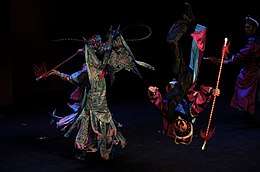
| Music of China | |
|---|---|
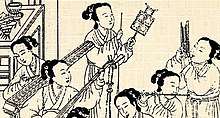 | |
| General topics | |
| |
| Genres | |
| Specific forms | |
| Media and performance | |
| Music festivals | Midi Modern Music Festival |
| Music media |
|
| Nationalistic and patriotic songs | |
| National anthem | |
| Regional music | |
| Chinese opera | |||||||||||||||||||
|---|---|---|---|---|---|---|---|---|---|---|---|---|---|---|---|---|---|---|---|
| Traditional Chinese | 戲曲 | ||||||||||||||||||
| Simplified Chinese | 戏曲 | ||||||||||||||||||
| |||||||||||||||||||
There are over a hundred regional branches of traditional Chinese opera today. In the 20th century the Peking opera emerged in popularity and has come to known as the "national theatre" of China,[2] but other genres like Yue opera, Cantonese opera, Yu opera, kunqu, qinqiang, Huangmei opera, pingju, and Sichuan opera are also performed regularly before dedicated fans. Their differences are mainly found in the music and topolect; the stories are often shared and borrowed.[3] With few exceptions (such as revolutionary operas and to some extent Shanghai operas) the vast majority of Chinese operas (including Taiwanese operas) are set in China before the 17th century, whether they are traditional or newly written.
For centuries Chinese opera was the main form of entertainment for both urban and rural residents in China as well as the Chinese diaspora. Its popularity declined sharply in the second half of the 20th century as a result of both political and market factors. Language policies discouraging topolects in Taiwan and Singapore, official hostility against rural religious festivals in China, and de-Sinicization in Taiwan have all been blamed for the decline of various forms in different times, but overall the two major culprits were Cultural Revolution — which saw traditional culture systematically erased, innumerable theatre professionals viciously persecuted, and younger generation raised with far lesser exposure to Chinese opera — and modernization, with its immense social impact and imported values that Chinese opera has largely failed to counter.[4] The total number of regional genres was determined to be more than 350 in 1957,[5] but in the 21st century the Chinese government could only identify 162 forms for its intangible cultural heritage list, with many of them in immediate danger of disappearing.[6] For young people, Chinese opera is no longer part of the everyday popular music culture, but it remains an attraction for many older people who find in it, among other things, a national or regional identity.
History
Six dynasties to Tang
An early form of Chinese drama is the Canjun Opera (參軍戲, or Adjutant Play) which originated from the Later Zhao Dynasty (319–351).[7][8][9] In its early form, it was a simple comic drama involving only two performers, where a corrupt officer, Canjun or the adjutant, was ridiculed by a jester named Grey Hawk (蒼鶻).[7] The characters in Canjun Opera are thought to be the forerunners of the fixed role categories of later Chinese opera, particularly of its comic chou (丑) characters.[10]
Various song and dance dramas developed during the Six Dynasties period. During the Northern Qi Dynasty, a masked dance called the Big Face (大面, which can mean "mask", alternatively daimian 代面, and it was also called The King of Lanling, 蘭陵王), was created in honour of Gao Changgong who went into battle wearing a mask.[11][12] Another was called Botou (撥頭, also 缽頭), a masked dance drama from the Western Regions that tells the story of a grieving son who sought a tiger that killed his father.[13] In The Dancing Singing Woman (踏謡娘), which relates the story of a wife battered by her drunken husband, the song and dance drama was initially performed by a man dressed as a woman.[12][14] The stories told in of these song-and-dance dramas are simple, but they are thought to be the earliest pieces of musical theatre in China, and the precursors to the more sophisticated later forms of Chinese opera.[12][15]
These forms of early drama were popular in the Tang dynasty where they further developed. For example, by the end of the Tang Dynasty the Canjun Opera had evolved into a performance with more complex plot and dramatic twists, and it involved at least four performers.[16] The early form of Chinese theatre became more organized in the Tang dynasty with Emperor Xuanzong (712–755), who founded the "Pear Garden" (梨园/梨園; líyuán), the first academy of music to train musicians, dancers and actors.[17] The performers formed what may be considered the first known opera troupe in China, and they performed mostly for the emperors' personal pleasure. To this day operatic professionals are still referred to as "Disciples of the Pear Garden" (梨园弟子 / 梨園弟子, líyuán dìzi).[18]
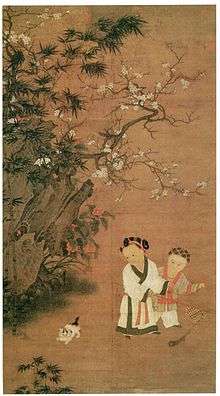
Song to Qing
By the Song Dynasty, Canjun Opera had become a performance that involved singing and dancing, and led to the development of Zaju (雜劇). Forms such as the Zaju and Nanxi (南戏) further matured in the Song dynasty (960–1279). In the Yuan dynasty (1279–1368), acts based on rhyming schemes and innovations such as specialized roles like Dan (旦, dàn, female), Sheng (生, shēng, male), Hua (花, huā, painted-face) and Chou (丑, chŏu, clown) were introduced into the opera. Although actors in theatrical performances of the Song Dynasty strictly adhered to speaking in Classical Chinese onstage, during the Yuan Dynasty actors speaking or performing lyrics in the vernacular tongue became popular on stage.[19]
In the Yuan poetic drama, only one person sang for the all four acts, but in the poetic dramas that developed from Nanxi during the Ming dynasty (1368–1644), all the characters were able to sing and perform. A playwright Gao Ming late in the Yuan dynasty wrote an opera called Tale of the Pipa which became highly popular, and became a model for Ming dynasty drama as it was the favorite opera of the first Ming emperor Zhu Yuanzhang.[20][21] The presentation by now resemble the Chinese opera of today, except that the librettos were then very long.[1] The operatic artists were required to be skilled in many fields; according to Recollections of Tao An (陶庵夢憶) by Zhang Dai, performers had to learn how to play various musical instruments, singing and dancing before they were taught acting.[22]
The dominant form of the Ming and early Qing dynasties was Kunqu, which originated in the Wu cultural area. A famous work in Kunqu is The Peony Pavilion by Tang Xianzu. Kunqu later evolved into a longer form of play called chuanqi, which became one of the five melodies that made up Sichuan opera.[23] Currently Chinese operas continue to exist in 368 different forms, the best known being Beijing opera, which assumed its present form in the mid-19th century and was extremely popular in the latter part of the Qing Dynasty (1644–1911).
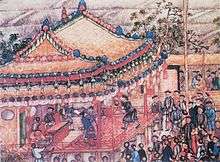
In Beijing opera, traditional Chinese string and percussion instruments provide a strong rhythmic accompaniment to the acting. The acting is based on allusion: gestures, footwork, and other body movements express such actions as riding a horse, rowing a boat, or opening a door. Spoken dialogue is divided into recitative and Beijing colloquial speech, the former employed by serious characters and the latter by young females and clowns. Character roles are strictly defined, and each character have their own elaborate make-up design. The traditional repertoire of Beijing opera includes more than 1,000 works, mostly taken from historical novels about political and military struggles.
1912–1949
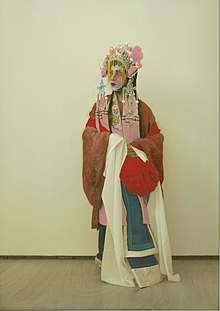
At the turn of the 20th century, Chinese students returning from abroad began to experiment with Western plays. Following the May Fourth Movement of 1919, a number of Western plays were staged in China, and Chinese playwrights began to imitate this form. The most notable of the new-style playwrights was Cao Yu (b. 1910). His major works—Thunderstorm, Sunrise, Wilderness, and Peking Man—written between 1934 and 1940, have been widely read in China.
The Republican Era saw the rise of Yue opera and all female Yue Opera troupes in Shanghai and Zhejiang. A woman-centric form, with all female casts and majority female audience members, plots were often love stories. Its rise was related to the changing place of women in society.
In the 1930s, theatrical productions performed by traveling Red Army cultural troupes in Communist-controlled areas were consciously used to promote party goals and political philosophy. By the 1940s, theater was well established in the Communist-controlled areas.
1949–1985
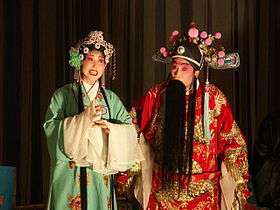
In the early years of the People's Republic of China, development of Peking opera was encouraged; many new operas on historical and modern themes were written, and earlier operas continued to be performed. As a popular art form, opera has usually been the first of the arts to reflect changes in Chinese policy. In the mid-1950s, for example, it was the first to benefit under the Hundred Flowers Campaign, such as the birth of Jilin opera. Opera may be used as commentaries on political affairs, and in November 1965, the attack on Beijing deputy mayor Wu Han and his historical play Hai Rui Dismissed from Office as anti-Mao, signaled the beginning of the Cultural Revolution. During the Cultural Revolution, most opera troupes were disbanded, performers and scriptwriters were persecuted, and all operas were banned except the eight "model operas" that had been sanctioned by Jiang Qing and her associates. Western-style plays were condemned as "dead drama" and "poisonous weeds", and were not performed. After the fall of the Gang of Four in 1976, Beijing Opera enjoyed a revival and continued to be a very popular form of entertainment, both on stage and television.
Present
In the 21st century, Chinese opera is seldom publicly staged except in formal Chinese opera houses. It may also be presented during the lunar seventh month Chinese Ghost Festival in Asia as a form of entertainment to the spirits and audience. More than thirty famous pieces of Kunqu opera continue to be performed today, including The Peony Pavilion, The Peach Blossom Fan, and adaptions of Journey to the West, Romance of the Three Kingdoms.
In 2001, Kunqu was recognized as Masterpiece of Oral and Intangible Heritage of Humanity by United Nations Educational, Cultural and Scientific Organization (UNESCO)
Costumes and make-ups

Exaggerated paints on opera performer's face which ancient warriors decorated themselves to scare the enemy are used in the opera; each color has a different meaning. They are used to symbolize a character's role, fate, and illustrate the character's emotional state and general character.
White symbolizes sinister, evil, crafty, treacherous, and suspicious. Any performer with white painted face usually takes the part of a villain of the show. The larger the white painted area, the crueler the role.
Green denotes impulsive behavior, violence, no self-restraint or self-control.
Red stands for bravery or loyalty.
Black denotes boldness, fierceness, impartiality, rough.
Yellow symbolizes ambition, fierceness, or intelligence.
Blue stands for steadfastness ( someone who is loyal and sticks to one side no matter what ).
Pink symbolizes sophistication, and cool-headedness.
Moreover, paint figures have different types. For instance, overall painted face, and only painted in the center of the face, connecting eyes and nose.
Musical Characteristics
Medium[24]
String Instruments
Traditional Chinese string instruments utilized in Chinese Opera include:
Percussion Instruments[25]
Traditional Chinese percussion instruments utilized in Chinese Opera include:
Regional genres
| English name | Chinese name(s) | Major geographical areas |
|---|---|---|
| Peking opera | Jingju (京劇) | Cities nationwide on mainland, Hong Kong, Taiwan |
| Kunqu | Kunqu (崑曲) or Kunju (崑劇) | Cities nationwide on mainland, Taiwan |
| Nuo opera | Nuoxi (傩戲) | Certain rural areas in Hunan, Hubei, Guizhou, Jiangxi, Guangxi, Anhui, Shanxi, Hebei |
| Northeast China | ||
| Longjiang opera | Longjiangju (龍江劇) | Heilongjiang |
| Jilin opera | Jiju (吉劇) | Jilin |
| Laba opera | Labaxi (喇叭戲) | Haicheng (central Liaoning) |
| North China | ||
| Ping opera | Pingju (評劇) | Hebei, Beijing, Tianjin, Heilongjiang, Jilin, Liaoning |
| Hebei bangzi | Hebei bangzi (河北梆子) | Hebei, Beijing, Tianjin, northwestern Shandong |
| Laodiao | Laodiao (老調) | Central Hebei, Beijing, Tianjin |
| Hahaqiang | Hahaqiang (哈哈腔) | Central Hebei, northwestern Shandong |
| Sixian | Sixian (絲弦) | Hebei, Shanxi |
| Sai opera | Saixi (賽戲) | Southern Hebei, northern Shanxi |
| Siguxian | Siguxian (四股弦) | Southern Hebei |
| Xidiao | Xidiao (西調) | Handan (southern Hebei) |
| Pingdiao | Pingdiao (平調) | Wu'an (southern Hebei) |
| Xilu Bangzi | Xilu Bangzi (西路梆子) | Haixing County (southeastern Hebei) |
| Shanxi opera | Jinju (晉劇) | Shanxi, western Hebei, central Inner Mongolia, northern Shaanxi |
| Yangge opera | Yanggexi (秧歌戲) | Shanxi, Hebei, Shaanxi, |
| Daoqing opera | Daoqingxi (道情戲) | |
| Errentai | Errentai (二人臺) | Northern Shaanxi, northwestern Shanxi, northwestern Hebei, central Inner Mongolia |
| Xianqiang | Xianqiang (線腔) | Southernmost Shanxi, westernmost Henan, eastern Shaanxi |
| Northwest China | ||
| Qinqiang | Qinqiang (秦腔) | Shaanxi, Gansu, Ningxia, Xinjiang |
| Tiao opera | Tiaoxi (跳戲) | Heyang County (central Shaanxi) |
| Guangguang opera | Guangguangxi (桄桄戲) | Hanzhong (southwestern Shaanxi) |
| Xiaoqu opera | Xiaoquxi (小曲戲) | Gansu |
| Quzi opera | Quzixi (曲子戲) | Northern Gansu, Xinjiang |
| Gaoshan opera | Gaoshanxi (高山戲) | Longnan (southern Gansu) |
| Henan and Shandong | ||
| Henan opera | Yuju (豫劇) | Henan, southern Hebei, Taiwan |
| Qu opera | Quju (曲劇) | Henan |
| Yuediao | Yuediao (越調) | Henan, northern Hubei |
| Wuyin opera | Wuyinxi (五音戲) | Central Shandong |
| Lü opera | Lüju (呂劇) | |
| Maoqiang | Maoqiang (茂腔) | Jiaozhou Bay (eastern Shandong) |
| Anhui and Jiangsu | ||
| Huangmei opera | Huangmeixi (黃梅戲) | Anhui, eastern Hubei, Taiwan |
| Sizhou opera | Sizhouxi (泗州戲) | Northeastern Anhui, northwestern Jiangsu |
| Lu opera | Luju (廬劇) | Central Anhui |
| Hui opera | Huiju (徽劇) | Southern Anhui, northeastern Jiangxi |
| Huaihai opera | Huaihaixi (淮海戲) | Northern Jiangsu |
| Yangzhou opera | Yangju (揚劇) | Yangzhou (central Jiangsu) |
| Huai opera | Huaiju (淮劇) | Central Jiangsu |
| Wuxi opera | Xiju (錫劇) | Wuxi and Changzhou (southern Jiangsu) |
| Suzhou opera | Suju (蘇劇) | Suzhou (southern Jiangsu) |
| Tongzi opera | Tongzixi (童子戲) | Nantong (southeastern Jiangsu) |
| Zhejiang and Shanghai | ||
| Yue opera | Yueju (越劇) | Zhejiang, Shanghai, southern Jiangsu, northern Fujian |
| Shanghai opera | Huju (滬劇) | Shanghai |
| Huzhou opera | Huju (湖劇) | Huzhou (northern Zhejiang) |
| Shao opera | Shaoju (紹劇) | Shaoxing (northern Zhejiang) |
| Yao opera | Yaoju (姚劇) | Yuyao (northern Zhejiang) |
| Ningbo opera | Yongju (甬劇) | Ningbo (northern Zhejiang) |
| Wu opera | Wuju (婺劇) | Western Zhejiang |
| Xinggan opera | Xingganxi (醒感戲) | Yongkang (central Zhejiang) |
| Ou opera | Ouju (甌劇) | Wenzhou (southern Zhejiang) |
| Fujian and Taiwan | ||
| Min opera | Minju (閩劇) | Fujian, Taiwan (particularly Matsu Islands), Southeast Asia |
| Beilu opera | Beiluxi (北路戲) | Shouning County (northeastern Fujian) |
| Pingjiang opera | Pingjiangxi (平講戲) | Ningde (northeastern Fujian) |
| Sanjiao opera | Sanjiaoxi (三角戲) | Northern Fujian, western Zhejiang, northeastern Jiangxi |
| Meilin opera | Meilinxi (梅林戲) | Northwestern Fujian |
| Puxian opera | Puxianxi (莆仙戲) | Putian (coastal central Fujian) |
| Liyuan opera | Liyuanxi (梨園戲) | Quanzhou (southern Fujian), Taiwan, Southeast Asia |
| Gaojia opera | Gaojiaxi (高甲戲) | Quanzhou (southern Fujian), Taiwan, Southeast Asia |
| Dacheng opera | Dachengxi (打城戲) | Quanzhou (southern Fujian) |
| Taiwanese opera | Gezaixi (歌仔戲) | Taiwan, southern Fujian, Southeast Asia |
| Hubei, Hunan, and Jiangxi | ||
| Flower-drum opera | Huaguxi (花鼓戲) | Hubei, Hunan, Anhui, southeastern Henan |
| Han opera | Hanju (漢劇) | Hubei, Hunan, Shaanxi, Taiwan |
| Chu opera | Chuju (楚劇) | Eastern Hubei |
| Jinghe opera | Jinghexi (荊河戲) | Southern Hubei, northern Hunan |
| Baling opera | Balingxi (巴陵戲) | Yueyang (northeastern Hunan) |
| Jiangxi opera | Ganju (贛劇) | Jiangxi |
| Yaya opera | Yayaxi (丫丫戲) | Yongxiu County (northern Jiangxi) |
| Meng opera | Mengxi (孟戲) | Guangchang County (eastern central Jiangxi) |
| Donghe opera | Donghexi (東河戲) | Ganzhou (southern Jiangxi) |
| Tea-picking opera | Caichaxi (採茶戲) | Jiangxi, Hunan, Guangxi, Hubei, Guangdong, Taiwan |
| Southwest China | ||
| Sichuan opera | Chuanju (川劇) | Sichuan, Chongqing |
| Yang opera | Yangxi (陽戲) | Northwestern Hunan, eastern Sichuan, Chongqing, Guizhou |
| Deng opera | Dengxi (燈戲) | Northeastern Sichuan, Chongqing, southwestern Hubei |
| Huadeng opera | Huadengxi (花燈戲) | Guizhou, Yunnan |
| Guizhou opera | Qianju (黔劇) | Guizhou |
| Yunnan opera | Dianju (滇劇) | Yunnan |
| Guansuo opera | Guansuoxi (關索戲) | Chengjiang County (central Yunnan) |
| South China | ||
| Cantonese opera | Yueju (粵劇) | Guangdong, Hong Kong, Macau, southern Guangxi, North America, Southeast Asia |
| Teochew opera | Chaoju (潮劇) | Eastern Guangdong, southernmost Fujian, Hong Kong, Southeast Asia |
| Zhengzi opera | Zhengzixi (正字戲) | Lufeng (eastern Guangdong) |
| Leizhou opera | Leiju (雷劇) | Leizhou Peninsula (southwestern Guangdong) |
| Hainan opera | Qiongju (瓊劇) | Hainan, Singapore |
| Zhai opera | Zhaixi (齋戲) | Haikou (northern Hainan) |
| Caidiao | Caidiao (彩調) | Guangxi |
| Guangxi opera | Guiju (桂劇) | Northern Guangxi |
| Nanning opera | Yongju (邕劇) | Nanning (southern Guangxi) |
- Puju (蒲剧) (Shanxi)
- Hakka opera (汉剧)
Gallery
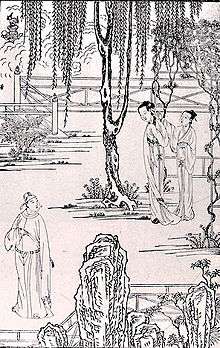 Print illustration of zaju plays by Yuan playwrights, a book of the Wanli period (1572–1620).
Print illustration of zaju plays by Yuan playwrights, a book of the Wanli period (1572–1620). Fire spitting from Sichuan opera
Fire spitting from Sichuan opera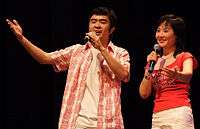 The informal costume of Huangmei opera
The informal costume of Huangmei opera A performer
A performer Chinese opera performer, Qing dynasty, 19th-20th century.
Chinese opera performer, Qing dynasty, 19th-20th century. A female opera performer
A female opera performer
See also
- Chinese culture
- Music of China
- Opera
- Pear Garden
- Qu (poetry)
- Yuan poetry
- Zaju
- Revolutionary opera
- Chinese contemporary classical opera
Notes
- Wang Kefen (1985). The History of Chinese Dance. China Books & Periodicals. p. 78. ISBN 978-0835111867.
- Mackerras, Colin (Spring 1994). "Peking Opera before the Twentieth Century". Comparative Drama. 28 (1): 19–42. JSTOR 41153679.
- Siu, Wang-Ngai; Lovrick, Peter (1997). Chinese Opera: Images and Stories. UBC Press. ISBN 0-7748-0592-7.
- Ma, Haili (2012). "Yueju – The Formation of a Legitimate Culture in Contemporary Shanghai". Culture Unbound: Journal of Current Cultural Research. 4: 213–227.
- Iovene, Paola (2010). "Chinese Operas on Stage and Screen: A Short Introduction". The Opera Quarterly. 26 (2–3): 181–199 – via Project Muse.
- "将优秀戏曲纳入"国家典藏"". Guangming Daily (in Chinese). May 9, 2017.
- Tan Ye (2008). Historical Dictionary of Chinese Theater. Scarecrow Press. p. 3. ISBN 978-0810855144.
- "唐代參軍戲". 中國文化研究院.
- "Sichuan Opera". Archived from the original on February 24, 2007.
- "The Tang Dynasty (618–907)". Asian Traditional Theatre and Dance.
- Laurence Picken, ed. (1985). Music from the Tang Court: Volume 5. Cambridge University Press. pp. 1–12. ISBN 978-0521347761.
- Faye Chunfang Fei, ed. (2002). Chinese Theories of Theater and Performance from Confucius to the Present. University of Michigan Press. pp. 28–29. ISBN 978-0472089239.
- Tan Ye (2008). Historical Dictionary of Chinese Theater. Scarecrow Press. p. 336.
- "Theatre". China Culture Information Net. Archived from the original on December 25, 2013.
- "The Early History of Chinese Theatre". Asian Traditional Theatre and Dance. Archived from the original on October 21, 2017. Retrieved March 11, 2014.
- Jin Fu (2012). Chinese Theatre (3rd ed.). Cambridge University Press. p. 10. ISBN 978-0521186667.
- Tan Ye (2008). Historical Dictionary of Chinese Theater. Scarecrow Press. p. 223. ISBN 978-0810855144.
- "Chinese Opera". onlinechinatours.com. Retrieved July 12, 2011.
- Rossabi, 162.
- Faye Chunfang Fei, ed. (2002). Chinese Theories of Theater and Performance from Confucius to the Present. University of Michigan Press. p. 41. ISBN 978-0472089239.
- Jin Fu (2012). Chinese Theatre (3rd ed.). Cambridge University Press. p. 447. ISBN 978-0521186667.
- "陶庵夢憶/卷02 《朱雲崍女戲》".
- "川 剧styles". 中国剧种大观 CCNT. Archived from the original on April 30, 2001.
- Canadian Museum of History,
- Computational Models for the Discovery of the World´s music, , Universitat Pompeu Fabra
References
- Rossabi, Morris (1988). Khubilai Khan: His Life and Times. Berkeley: University of California Press. ISBN 0-520-05913-1.
Further reading
| Wikimedia Commons has media related to Chinese opera. |
- Shih, Chung-wen (1976). The Golden Age of Chinese Drama: Yüan Tsa-chu. Princeton, NJ: Princeton University Press. ISBN 0-691-06270-6.
- Riley, Jo (1997). Chinese Theatre and the Actor in Performance. Cambridge, UK: Cambridge University Press. ISBN 0-521-57090-5.
External links
- "Traveling with the Jinju", a Deutsche Welle documentary depicting a 21st-century touring Jinju (晋剧) Shanxi Opera troupe